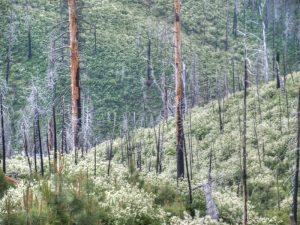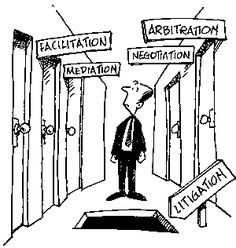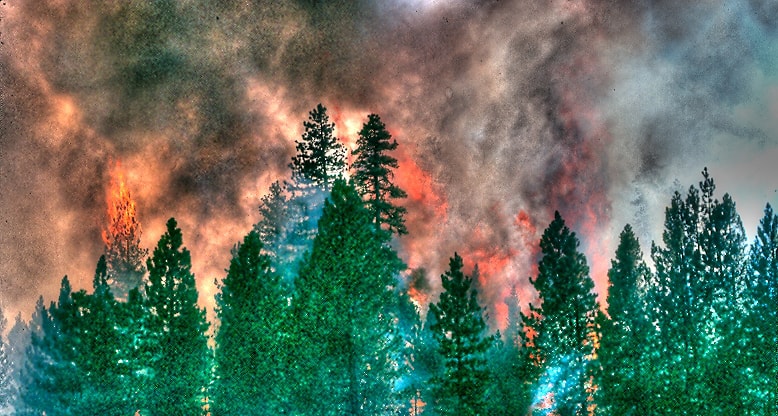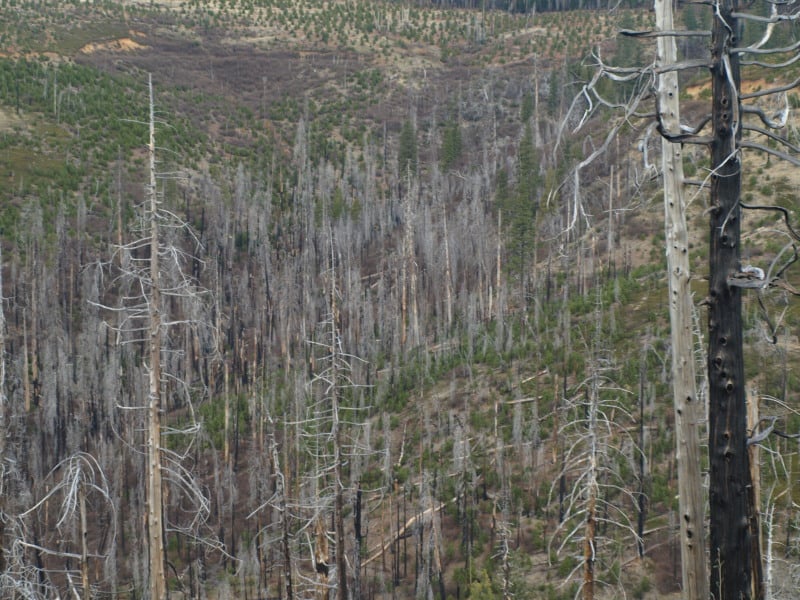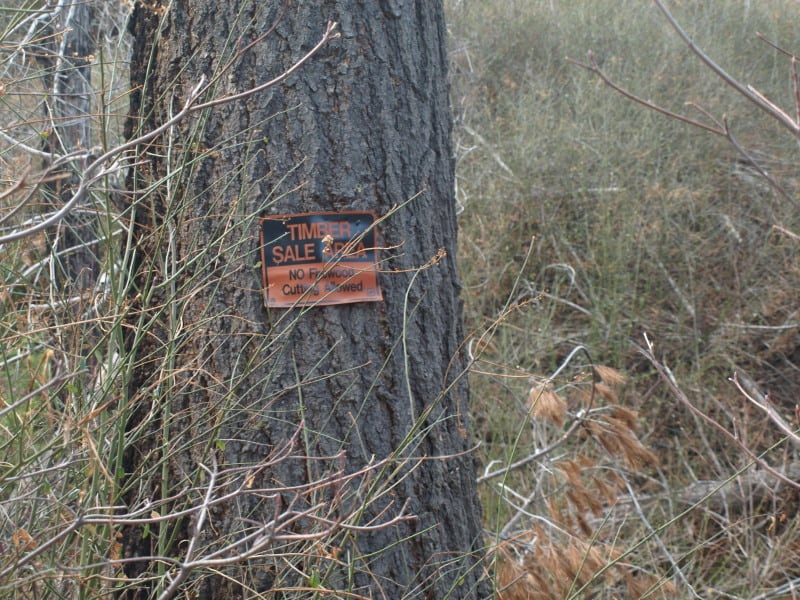“Natural Forest Regeneration”? (in the Eldorado National Forest.)
Reform and Enhance Litigation and Appeals
Arbitration/Mediation Pilots? The Westerman Bill and Other Ideas
I think it might be interesting to examine and discuss some of the specific ideas in the Westerman bill. The text of the arbitration section of the Westerman Bill is Title III subtitle B here. I like the idea of pilots- perhaps have two or three approaches and at the end of two years have a bipartisan commission or advisory committee (folks appointed from both parties and all sides of the issue) review how things worked. It seems to be different from the Barrasso bill that we discussed here in 2014, although the legal discussion about arbitration may still be valid.
I like how this process includes both Agriculture and Interior in the pilot, and how the arbitrator has to be approved by each party involved. I particularly like that each intervenor has to put its cards on the table in terms of going with the proposal, or submitting a modified proposal.
Another pilot might be a period of open, transparent public mediation perhaps done through the US Institute for Environmental Conflict Resolution (established by Congress for just these sorts of things). Not only would people have to put their cards on the table (put the public back in public policy) but it would be a great opportunity for science education (e.g., how do you know that this or that will or will not happen)?
Here’s a description of arbitration compared to mediation:
Arbitration and mediation are similar in that they are alternatives to traditional litigation, and sometimes they are used in conjunction with litigation (opposing parties may first try to negotiate, and if that fails, move forward to trial). Both arbitration and mediation employ a neutral third party to oversee the process, and they both can be binding. However, it is common to employ mediation as a non-binding process and arbitration as a binding process. In simpler terms, binding arbitration replaces the trial process with the arbitration process.
Arbitration is generally conducted with a panel of multiple arbitrators who take on a role like that of a judge, make decisions about evidence and give written opinions (which can be binding or non-binding). Although arbitration is sometimes conducted with one arbitrator, the most common procedure is for each side to select an arbitrator. Then, those two arbitrators select a third arbitrator, at which point the dispute is presented to the three chosen arbitrators. Decisions are made by majority vote.
Mediation, on the other hand, is generally conducted with a single mediator who does not judge the case but simply helps to facilitate discussion and eventual resolution of the dispute.
Somehow I like the idea of a panel of three arbitrators better than the one in the Westerman bill. Maybe that could be another idea tested in the pilots. Maybe Congress could pick two regions, one in the 9th Circuit and one in the 10th Circuit, and test these approaches on a sample of projects. Maybe a joint advisory group could be developed with folks from differing perspectives to select 20 projects to try each way and report back. Forty projects would not cause ecosystems to collapse nor species to go extinct (the group could even agree on a maximum number of acres treated in the pilot) and we might all learn something.
I bet there are other interesting approaches floating around. There is a group in Australia called PCERA who does this:
Second, PCERA provides a new model for expert determination called Collaborative Expert Resolution. This process involves an independent expert being appointed for each party to undertake an independent informal assessment of the merits of the case. The experts then meet and reach consensus, through a collaborative process, as to the resolution of the dispute on the merits. The assessment may be undertaken on a binding or non-binding basis. The outcome is a form of expert determination process in which the parties can work closely with the assessor appointed to consider their case, ensuring the merits of the case are addressed.
I like the idea of experts being involved in this approach.
Post-Election Thoughts About Our Forests?
With a new Republican President and a Republican-controlled Congress, how will this affect the Forest Service and the BLM?
Regarding the picture: I did some processing with a High Dynamic Range (HDR) program to get this artsy view. It is interesting that it enhanced the flames better than in the original scan, from a Kodachrome slide. I shot this while filling in on an engine, on the Lassen NF, back in 1988.
No TRO for the Rim Fire Salvage!
As I predicted, there will be no TRO for the Rim Fire, from District Court. Once the sales are sold, restoration work can begin. Let’s hope that SPI has an army of fallers, ready and waiting. I also hope that they will leave the plantation salvage for last. *smirk*
Sonora, CA –A Federal Judge in Fresno has denied a temporary restraining order regarding the lawsuit filed against the Rim Fire Recovery Record of Decision.
Forest Service Spokesperson Wyn Hornbuckle says, “We are pleased with the court’s decision.” He would not comment further.
As reported earlier this month, three environmental groups including the Center for Biological Diversity were seeking an injunction to halt logging within the 37 occupied California spotted owl territories within the burned area. The Chair of the Yosemite Stanislaus Solutions (YSS) group and President of Sierra Resource Management, Mike Albrecht, worked with local environmental groups and the Forest Service to hammer out a compromise on the Rim Fire Record of Decision. He applauds the Judge’s decision.
http://www.mymotherlode.com/news/local/223061/logging-injunction-denied.html
Collaborative objections?
This is apparently the first test of the 2012 planning rule objection process for forest plan revisions (though the plans were prepared under the 1982 rule). On the Kootenai, there were 38 objectors and the same number of ‘interested persons’ (presumably some overlap). On the Idaho Panhandle, 22 objectors and 94 interested persons. Someone distilled that to these four topics for discussion and possible resolution at a meeting on each forest: county coordination, Wild and Scenic Rivers, recommended Wilderness and wilderness study areas, and management indicator species. Meetings with objectors are optional, but if held must be open to the public (interested persons can participate but the general public can’t). The reviewing officer, Associate Deputy Chief Jim Pena, attended in person. What do you think?
Power Fire 2014
We’ve seen pictures of the Power Fire, on the Eldorado National Forest, before. I worked on salvage sales until Chad Hanson won in the Ninth Circuit Court, with issues about the black-backed woodpecker. The court decided that the issue needed more analysis, as well as deciding that the Forest Service’s brand new mortality guidelines were “confusing”. From these pictures, it is very clear to see that those mortality guidelines were way more conservative than they maybe should have been.
As you can see, in this finished unit(s), there were ample snags available for birds to use, despite multiple cuttings, due to the increased bark beetle activity, during the logging. No one can say that they didn’t leave enough snags, (other than the Appeals Court). These pictures are very recent, shot last month.
This picture amused me, as I put this sign up back in 2005. Plastic signs last much longer than the old cardboard ones.
Here is another view of the area, chock full of snags, well beyond what the salvage plans asked for, to devote to woodpeckers and other organisms that use snags. People like Chad Hanson want more high-intensity wildfires, and more dead old growth. It is no wonder that the Sierra Club decided he was too radical, even for them.
Edit: Here is the link to a previous posting from almost 2 years ago, with pictures. https://forestpolicypub.com/2012/05/28/the-power-fire-six-years-later/
Senate Committee Hearing: Challenges and opportunities for improving forest management on federal lands
A reader sent me this link: here’s his review:
Bill Imbergamo’s hit it out of the park with his oral and written testimony. I wanted to give him a hug.
Norm Johnson was awesome about the variable retention and science, children’s books, etc
Risch was spot-on also.
If you haven’t watched, I highly recommend it. VERY worthwhile investment of time.
So far I managed to get to a part where Wyden notes that NEPA “requires a strong stomach” or something equivalent, somehow I couldn’t find it when I went back..
There’s a great deal to think about here.. I am not as sanguine as the Chief about large landscape NEPA. If someone wants to, couldn’t they go to court after a big blow down or fire (or new climate models or ???) and ask for a redo on the basis of new information and changed conditions? Fundamentally, it would require a change with some folks giving up power, which people usually don’t do voluntarily. Especially those who really believe that they have the right perspective.
The Black Hills doesn’t have any of those ESA animals which are involved in all the Montana and other lawsuits.. is that a coincidence? Perhaps not as applicable as a person might think. I feel like the Administration likes to think things will be fine if collaboration is done and they do huge NEPA. I am a fairly optimistic person but I don’t see that changing, say, Mr. Garrity’s view on the couple of R-1 timber sales because the NEPA is at a larger scale.
The pilots have a great deal of attention and support, in terms of getting various barriers out of the way. Even if the pilots are successful, this does not necessarily predict that everyday kinds of work will be equally successful. My optimism tells me that we would get further by determining what the real barriers to active forest management are.
Anyway, there’s a lot here. What’s your favorite quote? Did you want to hug anyone?
Observations on Some Current Cases, and Introducing REAL
I think we really need to start a group toward reforming environmental conflict resolution as currently carried out through the court system.
We need an acronym.. for the time being, I will use REAL for “Reforming and Enhancing Appeals and Litigation” as it pertains to environment and natural resource disputes, particularly in public lands. Other acronym suggestions are welcome. You all have given me ideas, plus others outside this blog have, for ideas and actions that we may or may not agree to support in terms of:
1) Increasing transparency, public participation, and accountability in the resolution of disagreements involving public lands,
2) Through either direct action, or influencing legislation or Administration policy.
So I will be rounding up some of those ideas in the next few weeks.
I ran across these three pieces that help make my case for action:
1. (Litigation does not addressing the real issue). This story is “Feds file litigation to weaken ranchers’ claim” here. Where’s the best available, or any, “science” for that matter? Nowhere to be seen. It seems to me like conflict resolution folks could have been brought in on this to mediate the real issues, which seem to be 18% reduction, and not the Constitution. Likely to be more cost-effective to the taxpayer and more effective. But there could be history here that I’m not aware of, so those who know more, please speak up.
2. (Litigation does not address the real issue) Thanks to Terry Seyden for this one. This was in Forbes. This is a big enough deal that many folks are involved, including timber industry, and SAF (needed to be transparent about that). The same arguments could be made that this author makes,about other tinier projects, only without the broad base of (financial and other forms of) support.
On December 3, the U.S. Supreme Court will consider who is best suited to set national environmental policy – the experienced scientists and regulators at the Environmental Protection Agency or activist trial lawyers.
..
and
The former dean of the Yale School of Forestry and Environmental Studies, John Gordon, worries that, “Injecting permit requirements into this [BMP] process will only make the ongoing upgrade of our [environmental protection] methods slower and more expensive, diverting resources from reducing sediment to the legal machinery of permit review and litigation.” “In this case, environmental activists are not on the side of the environment,” he concluded. The EPA agrees; regulators have insisted for decades that permitting was not designed for—and does not work for—forest road runoff even as state forest road BMPs are widely acknowledged to have proven effective and efficient.
When the Supreme Court convenes on December 3rd, the critical question will be whether 35 years of effective regulation from EPA should be surrendered to America’s lawsuit industry.
To be fair, let’s take a look at this fellow’s background here. He is not one of our experienced folks in this area.. still he doesn’t claim that his opinions are a “scientific report.”
3. (Understanding the intricacies of the legal processes is not always easy, plus not addressing the real issue, plus not clear where the scientific information would lead.) Here is a link.
But Monday, U.S. District Court Judge John L. Kane rejected the settlement. At issue is a provision saying if there is a dispute over the implementation of the document, neither side can be found in contempt of court. The judge ruled that provision exceeds the authority of the two sides and could lead to them not reporting violations of the court order.
Tim Ream, attorney for the environmental group, called it a “very esoteric point” and said negotiations continue on reworking the settlement.
Dirt bike groups, who have funded and carried out maintenance work on the trails for years, have blasted the lawsuit as unfairly singling out dirt bike riders from hikers, mountain bike riders and others they say also impact the creek.
“We are not satisfied with the process to date,” said Don Riggle, president of the Colorado Springs-based Trails Preservation Alliance. His is one of three groups representing motorized vehicle riders that have joined the lawsuit as intervenors.
He said he agreed to a settlement with the Center for Biological Diversity with the understanding the ban would be in place only for the winter months, until the trails could be realigned, but last week’s settlement differed “in principle.” The document includes no timetable for reopening.
Here’s my information question, if three groups are intervenors, do they get to sit in while the settlement is discussed? To an outsider, seems like they should. Could someone explain how that works? ‘Cause otherwise it looks like a pretty closed door to the public.
